 | |||||||||
| The Shipyard: Ship Technical Information | |||||||||
|---|---|---|---|---|---|---|---|---|---|
| Series | The Shipyard | ||||||||
| Type | Engineering | ||||||||
| ID | 16172 | ||||||||
| Published | 2017-10-19 | ||||||||
| Source | The Shipyard: Ship Technical Information | ||||||||
| In the series | |||||||||
| |||||||||
Ship Technical Information
A Guide to the New Ship Matrix
Greetings Citizens!
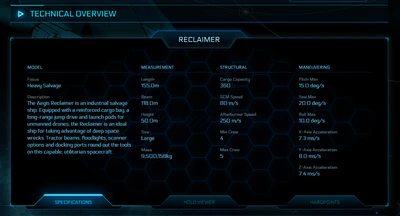
The New Ship Matrix retains a similar format to the prior matrix with three distinct panels: Systems, Technical Overview, and Holoviewer that have been adjusted and updated to support the breadth of new data involved. In this article we’ll be discussing the expanded Technical Overview section, where you can find a variety of information not typically suited for display via icons on the Systems panel. This also has the added benefit of allowing us to present a more raw data to the reader in certain instances.
Before we begin, a few words about stats in general.
Quite often we find it said that more is automatically better with regards to ship stats, but in game design that is not always the case. With our intention to create a diverse universe, the idea that having more of one thing than another is not an automatic advantage. In many instances, it can be either boon or downside and depending on the circumstance, even lead to a significant disadvantage.
As an example, when talking Transport career ships it may seem like bigger is automatically better, but there are considerations to be made beyond simply, “How much can it carry?” For starters, the more you carry at one time the larger a target you become. A Hull-E can carry a phenomenal amount of cargo but along with that advantage it’s also an extremely large and vulnerable ship, unable to land with the cargo and slow to load, due to it’s sheer size and the fact it stores all of that cargo externally. The risk in taking one of these ships on a long trading run or outside UEE protected shipping lanes is not only sizable, but will also require considerable expense in buying that cargo to start. Then again, there’s also the additional expense of offsetting that risk by hiring an escort to protect you. With this said, should you succeed the individual payoff can be spectacular. We mention this not to dissuade you from flying a Hull-E, but to encourage you think about what considerations should be taken in each situation, be that doing the same trip, multiple times, in another smaller, more protected ship and in greater safety, or taking the high-risk, high-reward path. These choices are meant to be yours, and ship stats are the basis for beginning these thoughts, not ending or limiting them. As one starship captain would put it: “I like to believe that there are always possibilities.”
With this same regard to Combat ships, the Buccaneer may wield an impressive array of weapons allowing it to pack one hell of a punch, but it’s trade-off in game design is that it cannot absorb a wealth of firepower in return. Trade-offs like these and others are essential in both game design, and in building the immersive universe Star Citizens deserve, and can often be offset by practice with a specific ship, individual understanding of each ship’s unique characteristics, and honing your dogfighting skills in general. Those that do can put these things to great use, but for the mere Content Manager mortals amongst us, we would probably fair better in a more rugged combat ship with slightly fewer guns and more missiles.
In the final analysis, your best bet will often be in finding the right combination of pilot, ship, and situation as opposed to just picking the one with the higher number. Which spaceship, is the right spaceship for you?
With that, there’s a fair chunk of newly available information contained here so lets dig down into each area and see what they’re all about.
Ship Size
The Size value is a simplified overview of both the scale of a ship’s physicality, and the scope of its player investment. While these values are not absolutes i.e. some Capital ships may be smaller, some Medium ships may be larger, it is intended only to be a starting point in your understanding of a particular ship’s place in the Star Citizen universe, and not the final word on what it can and cannot do.
| ||||
|---|---|---|---|---|
| Ship Size | Sample Ships | |||
| Vehicle | Ursa | Lynx | Cyclone | PTV |
| Snub | Archimedes | X1 | 85X | Dragonfly |
| Small | Defender | Razor | Sabre | Terrapin |
| Medium | Freelancer | Eclipse | Cutlass | Vanguard |
| Large | Carrack | Reclaimer | Merchantman | Constellation |
| Capital | Orion | Hull-E | Endeavor | Polaris |
| * This is a partial selection of ships for various sizes. | ||||
Vehicle
Can only be operated on ground, the range spans from simple personal transport vehicles like the Greycat, through exploration rovers like the Lynx and Ursa to much larger vehicles. Can often be crewed by a single player or a small group.
Snub
A ship that is completely dependent on another ship to work over a wide area. Sometimes referred to as a parasite craft. Will work in space and atmosphere with generally only a single pilot. Often has no Quantum Drive or fuel intakes which limit its range without the parent ship.
Small
Generally up to 25m in length. Ships that operate in space with Quantum capability. Ideal for solo operators but not exclusively single-seaters. Appropriate for the vast majority of landing pads on stations throughout the verse.
Medium
Most commonly 25-50m in length. Can be operated independently, but will flourish most effectively with additional crew. Often contains living accommodations for the crew to support extended missions or some form of cargo area. Designed to be played with a small group of friends well.
Large
Frequently found in the 50-150m length range, these ships can be operated with a skeleton crew, but really require an experienced medium to large crew working together as a unit throughout the mission to achieve their goals. Maintenance and repair costs often become a significant factor in this size bracket.
Capital
Huge ships that are often (but not exclusively) over 150m in length and require a significant investment in time or crew to maintain let alone run. The crew needs to be skilled in many areas to effectively operate these colossal ships and often need a small fleet of supporting ships to keep them in the best condition or out of harms way. While these ships are not designed for the casual, individual player, they will offer a unique gameplay experience to the dedicated crew who put in the time and resources.
Dimensions

These values have all been updated to the current dimensions for the ships based on their in-flight position rather than with their gears down.
Mass
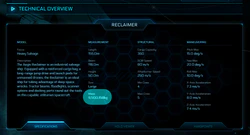
We discussed Ship Mass yesterday so check the article out for how we arrive to this number, but compared with the previous values they will appear significantly higher than before. Every ship has had a pass and been updated so while they are all higher, they are now all on the same scale. Generally the dimensions of the ship will factor more into the size classification than the mass. That said, the majority of the ships fall in line with this so “Small” will usually have a lower mass than “Medium,” but we’re leaving room in the future to have ships with particularly dense or light materials straddling traditional size conventions.
Cargo Capacity
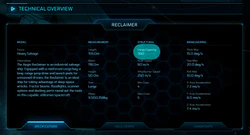
This value is the maximum amount of cargo in SCU the ship can safely carry when attached to its cargo grid in the dedicated cargo storage areas, and does not factor in the player attempting to fill every, corridor, nook and cranny with goods. As we’re discussing Cargo and SCU in detail in another article, for now we’ll say that we calculate this value using 1 SCU crates as the minimum size available to be placed and secured in the dedicated cargo grid (if any) of a ship.
SCM/AFB
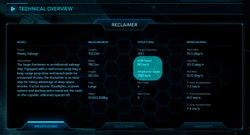
The SCM value is the speed the ship moves in Standard Combat Maneuvering mode, i.e. the default, in-space movement speed of your ship. In atmosphere this speed will often be less due to the increased air resistance and drag. The Afterburn (AFB) value is split into two, the first being the standard Afterburner top speed and the second in brackets being the “Super Cruise” max speed. This Super Cruise allows for travelling at a much greater velocity than AFB, but less than Quantum travel, perfect for navigating down to planets or moons from the outer markers. You’re always in such a hurry, aren’t you?
Min/Max Crew
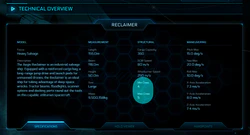
The minimum crew value is what we regard the minimum number of players (or hired NPC’s) to be able to operate the ship in a basic manner while still utilizing its key features, such as a salvage ship being still able to salvage and move/defend itself. We have calculated this number based on a few guidelines:
- Number of “operator” seats in the ship. These are seats that control specific functions such as flight, feature critical stations like salvage or mining, or drone control stations that are used to operate other primary features.
- Number of turrets divided by 2, rounded down. This provides the ship with a limited set of defense capability with the minimum crew rather than leaving it entirely undefended.
The maximum crew value is the upper limit of crew we allow to be supported onboard long term, not including passengers. The upper value is generally restricted by the amount of decidated seats for functions such as flight or turrets alongside the number of beds in the ship (where applicable.) Just like cargo these are the safe numbers. You can clown car an Aurora if you wish (we’ve seen the videos) but the on-board life support systems are finely tuned to only support the maximum crew for extended durations, so expect your resources to be consumed faster than expected.
Maneuvering Stats
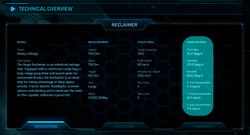
In the next article, we’ll be discussing the changes to how we display thrusters in the matrix with greater depth, but for now the key information for how your ship handles can be found here. These values are the raw, unmodified speeds your ship can translate/roll in each axis without using boost or afterburn. As such, these times are never exact and can be improved both by using the various speed functions of your ship, or in the future, by component performance tuning.
This article is intended as a brief introduction to the various information you’ll find on the Technical Information tab of the ship matrix. As with most aspects of Star Citizen’s continuing development, this information is reflective of the current design in ship stats, and may evolve further in the future.
Frequently Asked Questions
or: Questions We Figured You Might Have
Q: Why are the SCM/AFB set at certain values and restricted?
A: In reality there is theoretically no set limit for speed in space, but we restrict this for two reasons in Star Citizen: gameplay and technical.
The SCM values are built around where we want each ship to perform from a design perspective and ensure that the ship can still do maneuvers as expected and within G-Force limits. The higher these SCM speeds are the harder it is for compelling combat to occur, with the majority of players doing little more than “shooting at blips” instead of having exciting, skill-based dogfighting where you can see your opponents.
This also factors into the Afterburn top speed limitation as well, as we strive to make each ship feel different and provide reasons to either customize your ship, or look for ship alternatives while avoiding that, “best ship at everything” that can inhibit multi-faceted game design.
Q: Can I still fly my ship Solo even though the Min Crew is listed as more than 1?
A: Yes. While there is no hard and fast rule excluding the solo operation of all Large or Capital ships, some may find themselves at a significant disadvantage trying to perform specific actions in multi-crew ships without a crew, be that player or AI-based. Every ship in the game can be flown by a single player (even a Javelin) but your effectiveness in most scenarios will be limited to varying degrees. The minimum crew number provided is what we deem as a sensible skeleton crew option that allows the ship to be used effectively as intended while performing the role it was designed for.
For ships not implemented in the game, this is an estimate based on design intentions. As with all game development, these numbers can change after implementation, testing, and feedback.
Q: How does Ship Size tie into Jump Point sizing?
A: At present, while we focus building out the single Stanton System, the Ship Size value has no bearing on the Jump Point sizing you can find in the Starmap. While the game system determining which ships can use which jump points is still having its design finalized, we can offer that it is not expected that these “ship sizes” will map 1:1 with “jump point sizes.” We are working on multiple methods to determine jump point traversal and will update everyone (and the ship matrix) in the future once this system is finalized, and we are in a position to confirm this.
Q: Can I fit more cargo in my ship that the value suggested?
A: Yes, but do not expect this to be penalty free. We will cover this topic in depth in a further post but the value given is the current maximum safe amount of cargo each ship can carry, any more will be at risk of damage during flight and other penalties.











